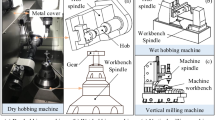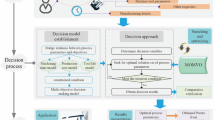Abstract
Dry hobbing is a new gear machining process with high efficiency and environmental friendliness, replacing traditional wet hobbing process. However, to get high reliable precision, it is a critical work for the dry hobbing system to reduce and control the thermal impact. Even new hobbing machine tool structure with high thermal stability such as double stand columns was designed to substitute the traditional structure; some new structures, such as air extraction and filtration device, air-cooling component, and magnetic chip conveyor, would affect the thermal energy accumulation of dry hobbing machine tool. In this paper, a multi-variable thermal energy control model was developed to describe the thermal energy accumulation characteristic of dry hobbing machine tool. Variables which would affect thermal energy generation and sink of dry hobbing machine tool are analyzed. A multi-objective optimization algorithm is proposed for variable optimization, combined with the multi-variable thermal energy control model. An application method is presented to show the thermal energy control procedure of dry hobbing machine tool. As a result, the temperature variation of interior space air, workpiece column, and anterior end cover is fluctuated in an acceptable range with optimization. Furthermore, thermal deformation errors, which range from −7 to 3 μm, could meet production requirements. It illustrates that the multi-variable driving thermal energy control model of dry hobbing machine tool is available.
Similar content being viewed by others
References
Bryan J (1990) International status of thermal error research. CIRP Ann Manuf Technol 39(2):645–656. doi:10.1016/S0007-8506(07)63001-7
Holkup T, Cao H, Kolář P, Altintas Y, Zelený J (2010) Thermo-mechanical model of spindles. CIRP Ann Manuf Technol 59(1):365–368. doi:10.1016/j.cirp.2010.03.021
Kim J, Jeong YH, Cho D (2004) Thermal behavior of a machine tool equipped with linear motors. Int J Mach Tools Manuf 44(7):749–758. doi:10.1016/j.ijmachtools.2004.02.006
Huang J, Zhou Z, Liu M, Zhang E, Chen M, Pham D, Ji C (2015) Real-time measurement of temperature field in heavy-duty machine tools using fiber bragg grating sensors and analysis of thermal shift errors. Mechatronics 31:16–21. doi:10.1016/j.mechatronics.2015.04.004
Abele E, Sielaff T, Schiffler A, Rothenbücher S (2011) Analyzing energy consumption of machine tool spindle units and identification of potential for improvements of efficiency. (pp. 280–285). Berlin, Heidelberg: Springer Berlin Heidelberg. doi:10.1007/978-3-642-19692-8_49
Abele E, Altintas Y, Brecher C (2010) Machine tool spindle units. CIRP Ann Manuf Technol 59(2):781–802. doi:10.1016/j.cirp.2010.05.002
Li Y, Zhao W, Wu W, Lu B, Chen Y (2014) Thermal error modeling of the spindle based on multiple variables for the precision machine tool. Int J Adv Manuf Technol 72(9):1415–1427. doi:10.1007/s00170-014-5744-4
Sarhan AAD (2014) Investigate the spindle errors motions from thermal change for high-precision CNC machining capability. Int J Adv Manuf Technol 70(5):957–963. doi:10.1007/s00170-013-5339-5
Züst S, Gontarz A, Pavliček F, Mayr J, Wegener K (2015) Model based prediction approach for internal machine tool heat sources on the level of subsystems. Procedia CIRP 28:28–33. doi:10.1016/j.procir.2015.04.006
Bossmanns B, Tu JF (1999) A thermal model for high speed motorized spindles. Int J Mach Tools Manuf 39(9):1345–1366. doi:10.1016/S0890-6955(99)00005-X
Sreejith PS, Ngoi BKA (2000) Dry machining: machining of the future. J Mater Process Technol 101(1):287–291. doi:10.1016/S0924-0136(00)00445-3
Cao H, Zhu L, Li X, Chen P, Chen Y (2016) Thermal error compensation of dry hobbing machine tool considering workpiece thermal deformation. Int J Adv Manuf Technol 86(5):1739–1751. doi:10.1007/s00170-015-8314-5
Weinert K, Inasaki I, Sutherland JW, Wakabayashi T (2004) Dry machining and minimum quantity lubrication. CIRP Ann Manuf Technol 53(2):511–537. doi:10.1016/S0007-8506(07)60027-4
Schindler S, Zimmermann M, Aurich JC, Steinmann P (2014) Thermo-elastic deformations of the workpiece when dry turning aluminum alloys—a finite element model to predict thermal effects in the workpiece. CIRP J Mech Sci Technol 7(3):233–245. doi:10.1016/j.cirpj.2014.04.006
Han J, Wang L, Wang H, Cheng N (2012) A new thermal error modeling method for CNC machine tools. Int J Adv Manuf Technol 62(1):205–212. doi:10.1007/s00170-011-3796-2
Wu CW, Tang CH, Chang CF, Shiao YS (2012) Thermal error compensation method for machine center. Int J Adv Manuf Technol 59(5):681–689. doi:10.1007/s00170-011-3533-x
Friderikos O, Maliaris G, David CN, Tsiafis I (2011) An investigation of cutting edge failure due to chip crush in carbide dry hobbing using the finite element method. Int J Adv Manuf Technol 57(1):297–306. doi:10.1007/s00170-011-3298-2
Claudin C, Rech J (2009) Development of a new rapid characterization method of hob’s wear resistance in gear manufacturing—application to the evaluation of various cutting edge preparations in high speed dry gear hobbing. J Mater Process Technol 209(11):5152–5160. doi:10.1016/j.jmatprotec.2009.02.014
Incropera FP, DeWitt DP, Bergman TL, Lavine AS (2007) Fundamentals of heat and mass transfer, 6th edn. J. Wiley, New York
Dogu Y, Aslan E, Camuscu N (2006) A numerical model to determine temperature distribution in orthogonal metal cutting. J Mater Process Technol 171(1):1–9. doi:10.1016/j.jmatprotec.2005.05.019
Fratila D (2009) Evaluation of near-dry machining effects on gear milling process efficiency. J Clean Prod 17(9):839–845. doi:10.1016/j.jclepro.2008.12.010
Chen X, Liu J, He Y, Zhang P, Shan W (2013) Thermal properties of high speed motorized spindle and their effects. Jixie Gongcheng Xuebao/J Mech Eng 49(11):135–142. doi:10.3901/JME.2013.11.135
Kauschinger B, Schroeder S (2016) Uncertainties in heat loss models of rolling bearings of machine tools. Procedia CIRP 46:107–110. doi:10.1016/j.procir.2016.03.168
Shi H, Ma C, Yang J, Zhao L, Mei X, Gong G (2015) Investigation into effect of thermal expansion on thermally induced error of ball screw feed drive system of precision machine tools. Int J Mach Tools Manuf 97:60–71. doi:10.1016/j.ijmachtools.2015.07.003
Koffel G, Ville F, Changenet C, Velex P (2009) Investigations on the power losses in gear transmissions. ARCHIVE Proceedings of the Institution of Mechanical Engineers Part J Journal of Engineering Tribology 1994–1996 (vols 208–210) 223(3):469–479
Chen Y, Cao H, Li X, Chen P (2016) The model of spatial forming with multi-cutting-edge for cylindrical gear hobbing and its application. Jixie Gongcheng Xuebao/J Mech Eng 52(9):176–183. doi:10.3901/JME.2016.09.176
Dimitriou V, Antoniadis A (2009) CAD-based simulation of the hobbing process for the manufacturing of spur and helical gears. Int J Adv Manuf Technol 41(3):347–357. doi:10.1007/s00170-008-1465-x
Vargaftik NB, Touloukian YS (1975) Tables on the thermophysical properties of liquids and gases: in normal and dissociated states, 2nd edn. John Wiley & sons,inc, New york
Library WE (1979) American society of heating, refrigerating and air-conditioning engineers. Int J Refrig 2(3):56–57
Lemmon EW, Huber ML, Mclinden MO (2010) Nist standard reference database 23: reference fluid thermodynamic and transport properties-refprop. 9.0
Thiede S, Herrmann C, Kara S (2011) State of research and an innovative approach for simulating energy flows of manufacturing systems. Glocalized Solutions for Sustainability in Manufacturing—Proceedings of the 18th CIRP International Conference on Life Cycle Engineering 335–340. doi:10.1007/978-3-642-19692-8-58
Author information
Authors and Affiliations
Corresponding author
Rights and permissions
About this article
Cite this article
Zhu, L., Cao, H., Zeng, D. et al. Multi-variable driving thermal energy control model of dry hobbing machine tool. Int J Adv Manuf Technol 92, 259–275 (2017). https://doi.org/10.1007/s00170-017-0086-7
Received:
Accepted:
Published:
Issue Date:
DOI: https://doi.org/10.1007/s00170-017-0086-7




